Heading out the door? Read this article on the new Outside+ app available now on iOS devices for members! Download the app.
Every year, tents get lighter, stronger, and more sustainable. The newest batch of three-season shelters is no exception, with spacious, feature-packed options for an entire family, bombproof fortresses for pushing into the fourth season, and affordable designs for the occasional weekend warrior. The eight winners of this year’s exhaustive testing process proved themselves over and over in wind, rain, and even snow.
At a Glance
- Best Weather Protection: Slingfin Portal 2 ($560)
- Best Features: Sea to Summit Telos TR2 ($449)
- Most Livable: REI Half Dome 2 ($299)
- Best Three-Person: Big Agnes Copper Spur UL3 ($600)
- Most Versatile: Tarptent Double Rainbow ($349)
- Best Organization: MSR Hubba Hubba LT 2 ($550)
- Best Budget Tent: The North Face Trail Lite 2 ($325)
- Best Space-to-Weight Ratio: NEMO Hornet OSMO 3 ($530)
- Other Products We Tested
- How to Choose a Three-Season Tent
- How We Tested
- Meet Our Testers
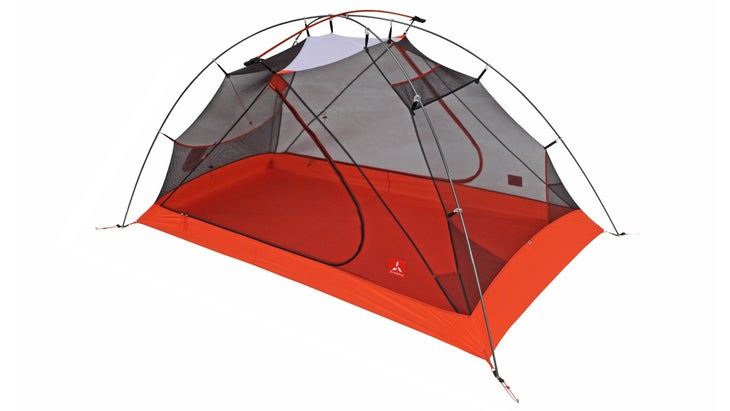
Best Weather Protection
SlingFin Portal 2
Weight: 2.9 lbs
Peak Height: 44”
Interior Space: 27 sq ft
Vestibule Space: 17 sq ft
Pros and Cons
⊕ Lightweight
⊕ Easy to set up
⊕ Stable in high winds
⊕ Good storage
⊗ Smaller floorplan
The sub-three-pound Portal 2 withstands high winds and nasty weather better than tents twice its weight. That’s thanks to a setup that includes three separate aluminum poles—minimizing the vulnerable pressure points common in hub systems—and a unique, internal guy line system to tighten the pitch and provide lateral stability. “We had 40-mph winds, but the tent never pancaked on us,” said one tester after a rough night at Thousand Island Lake in California’s Sierra National Forest.
Weather protection is further bolstered by ten external guylines and two hook-and-loop trekking pole attachment points on the top crosspole for added stability. “This is a bomber-type tent that’s easy and straightforward to set up,” reported one tester. “I would feel completely comfortable camping in any conditions, even a winter storm.”
The freestanding Portal’s 27-square-foot floor is average, but complemented by double doors and more than 16 square feet of vestibule space. Thanks to the mesh interior walls and two kickstand vents on the fly, condensation was nonexistent, even on 40-degree nights in Moab. A 10-denier nylon fly and 20-denier nylon floor are on the thin side of the spectrum, although we experienced no issues with durability during testing, even when camping on sandstone in Utah and rocky terrain in Colorado.
Waiting out storms is easy from the inside, too: An above-average peak height of 44 inches makes tasks like changing clothes and playing long card games relatively painless. A generous seven pockets—two ceiling, two head, two side, and one foot—keep small items like headlamps organized for longer stays.
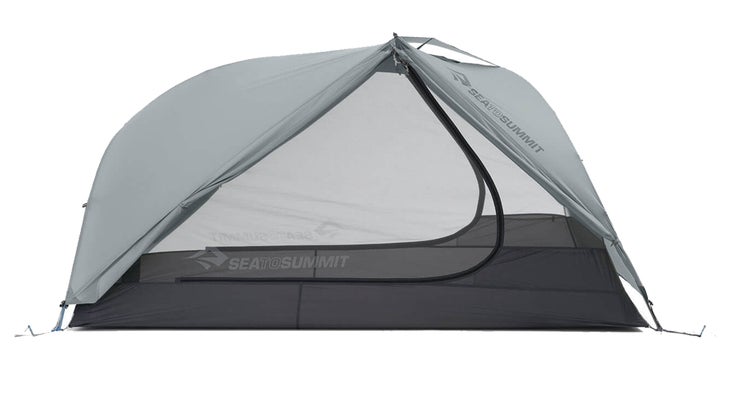
Best Features
Sea to Summit Telos TR2
$449 at REI $449 at Sea to Summit
Weight: 3.6 lbs
Peak Height: 43.5”
Interior Space: 28 sq ft
Vestibule Space: 19.5 sq ft
Pros and Cons
⊕ Large vestibules
⊕ Modular, multi-purpose design
⊕ Strong organization and storage
⊕ Packable
⊗ Pricey
If the devil is in the details, then the Sea to Summit Telos 2 is the most unholy tent we’ve ever occupied. Multi-functional design built into nearly every sack and flap put most competing backpacking tents on notice in the feature department.
The translucent tent pole storage sack, which can be clipped to the ceiling, turns your headlamp into a diffuse overhead light. The two stuff sacks for the fly and canopy snap into the corners to become large, stout storage pockets. And the fly is designed to be set up in “hangout mode” as a quick-pitch shelter to protect from sun, wind, or rain on the go (although you need to use trekking poles or separately purchased “hangout poles”). An adjustable, overhead storage attic is roomy enough for layers and strong enough for books. Three separate stuff sacks make splitting the tent up between backpackers extra easy, but they also can link together to form a single tent bag.
Beyond the modular design, testers loved the Telos 2’s clever pole structure: The single, multi-hubbed pole has an inverted V-shaped cross-pole that creates twin peaks and props up near-vertical interior walls. During testing, we found the cross-pole’s shape did well to shed water and prevent pooling while deflecting 25-mph winds at treeline in Colorado’s Indian Peaks Wilderness.
That cross-pole design allows its average-sized floor plan (28 square feet) to live a bit bigger than its specs, while two nearly 20-square-foot vestibules gobble up gear. Critically, the fly has four positions: locked down, half-way on for stargazing, rolled up, and propped out into the above mentioned hangout mode—a format for nearly every condition.
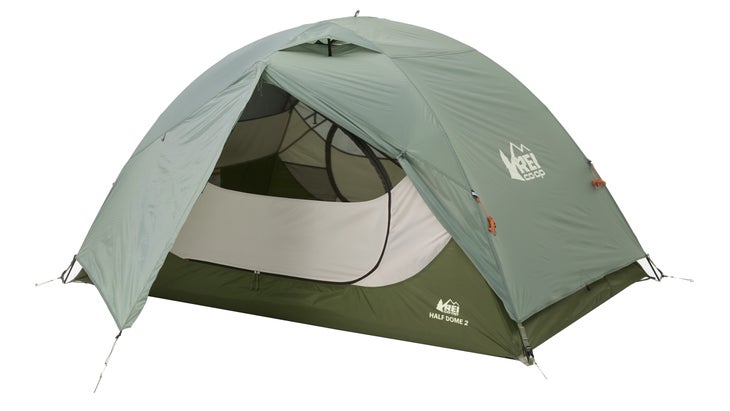
Most Livable
REI Half Dome 2
Weight: 5.75 lbs
Peak Height: 40”
Interior Space: 31.8 sq ft
Vestibule Space: 18 sq ft
Pros and Cons
⊕ Large interior floorplan
⊕ Durable
⊕ Good Value
⊗ Heavy
For the last two decades, our testers have considered REI’s Half Dome to be one of the best combinations of price, livability, ease of setup, and durability for weekend warriors. Our only complaint? Weather protection. With a 2025 update, that’s no longer an issue: The outdoor gear behemoth has increased the height of the interior ripstop nylon walls, which means more protection from wind, rain, and blowing sand.
Livability is still the Half Dome’s strongest attribute. A new pole structure spreads out the top of the tent, making up for an average peak height of 40 inches with a larger interior volume. It boasts a floorplan that’s 88 inches in length and offers more than 31 square feet of interior floor space, as well as two nine-square-foot vestibules. Livability scores were enhanced further by two large D-shaped doors and ample interior storage for headlamps, phones, and other small items in its six pockets—one at each bottom corner and two up top.
“I’m 5’11” and had plenty of headroom and space to sprawl out,” one tester said after a weekend in Big Dominguez Canyon, Colorado. “It’s extremely livable for two, and you could even squeak in a dog.”
Though it’s heavy by today’s standards at more than five and a half pounds, the Half Dome’s weight translates directly to durability. REI uses 40-denier ripstop nylon on the floor, body, and fly, the latter being an upgrade over previous versions. After years of camping on rocks and sandstone, we have no trust issues with the tent’s fabric choices, although an included 75-denier, seven-ounce footprint further adds to its longevity.
Two closeable ceiling vents and plenty of mesh in the upper portion of the tent body allow for adequate ventilation during cold nights and while waiting out storms, and our testers experienced no condensation on 35-degree nights in western Colorado. All-day rain was no problem for our North Carolina-based tester, who said the footprint and bathtub floors kept the interior dry when the ground turned soggy.
The top-loading stuff bag makes putting the tent away much easier than most other tents we tested—you no longer have to struggle to squeeze it back through the small side opening. The cherry on top? As it’s been in past years, the Half Dome is still a killer value at less than $300.
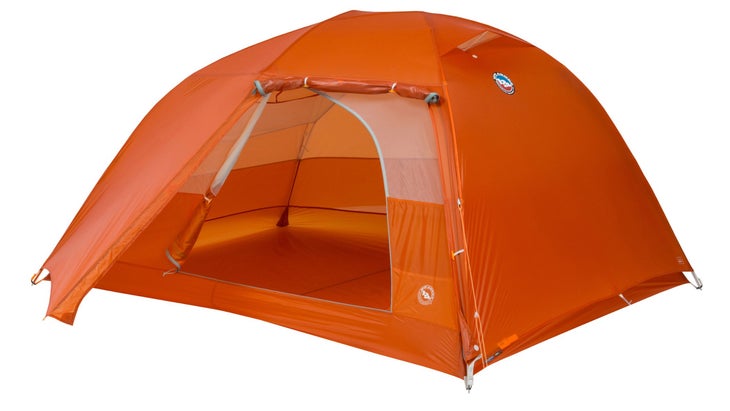
Best Three-Person
Big Agnes Copper Spur UL3
Weight: 3.8 lbs
Peak Height: 43”
Interior Space: 41 sq ft
Vestibule Space: 18 sq ft
Pros and Cons
⊕ Great space-to-weight ratio
⊕ Livable
⊕ Versatile
⊗ Pricey
Backpackers looking to size up from a two-person shelter, whether it’s for kids, pets, or a friend, will love the Copper Spur UL3 for its voluminous interior, low weight, and durability. Released this year as the successor to tester favorite, the Copper Spur HV3, the UL3 shaves two ounces with the same 41-square-foot interior.
The 90-inch length is a welcome sign for campers who are more than six feet tall, as is the 43-inch peak height, which allows for easy changing and sitting up. The 18 square feet of vestibule space is adequate for three pairs of packs and boots and extremely spacious for two. The Copper Spur UL3 has four storage pockets on the interior, including a large one overhead, to keep the floor uncluttered. “Even with cold-weather bags and gear, it was plenty livable for our trio of full-grown adults,” said one tester after a three-day backpacking trip to Yosemite National Park.
To achieve its low weight, Big Agnes uses a new proprietary “Hyperbead” ripstop nylon—a mix of 15- and 20-denier with a PFAS-free waterproofing—that our testers found to be impressively waterproof, even during overnight soakings in Mount Baker National Forest.
“The half-mesh tent body was great for controlling condensation and for stargazing on clear nights,” our tester reported. “The fly comes really low to the ground, and the pitch held strong during 15-mile-per-hour winds.”
DAC Featherlite aluminum hubbed poles and a bent cross-pole create the pitch, along with ample guy-out points for foul weather. Our trekking pole-equipped testers liked the option to create an awning with the fly doors for lazy mornings and cooking out of the rain. “If you stake it out correctly, you can fit a small camp chair underneath and have a place to sit down and eat in the shade,” one tester reported from the treeless terrain of Southern Utah.
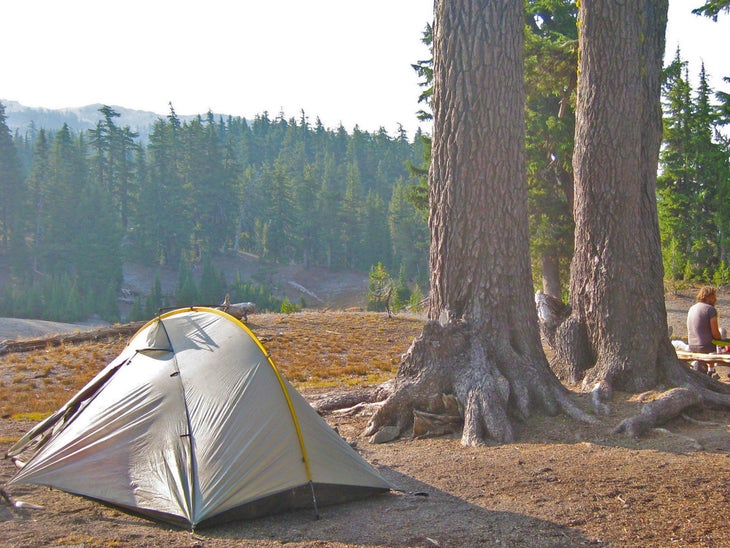
Most Versatile
Tarptent Double Rainbow
Weight: 2.6 lbs (with aluminum pole)
Peak Height: 42″
Interior Space: 30.6 sq ft
Vestibule Space: 16 sq ft
Pros and Cons
⊕ Lightweight
⊕ Affordable
⊕ Many configurations
⊗ Condensation
In 2010, we lauded the single-pole Double Rainbow for its low weight, ease of setup, and affordability, making it one of the best value buys on the market. The latest version has more space, better geometry, and a no-sag fly, making it a versatile proposition for backpackers transitioning into the world of trekking-pole shelters.
The new Double Rainbow is an improvement over the original in many ways. Most important to our testers? Enhanced livability. The 42-inch peak height combines with a wider top strut to expand headroom and increase interior volume overall. The 30.6-square-foot floor is larger than the previous iteration and many comparable two-person tents, easily fitting two full-size pads without complaints. “I never fit in tents, but my 6’1” dad and I were each able to sit upright,” said one 6’6” tester during a trip to the Pyrenees.
In its standard configuration, the semi-freestanding tent requires campers to properly stake it out to achieve a stable pitch, but our testers found it easy and logical to set up without practice, thanks to the simple single-pole design. Converting it into a fully freestanding tent is easy, too: slot a trekking pole (140 centimeters or longer) into both of the short ends of the tent for a guy-out-free pitch. And, using a combination of trekking poles and guylines to prop the vestibule awnings up, our testers could sit underneath, protected from the elements. It’s also a smart way to increase airflow into the tent—a useful trick to combat condensation, which is the single-walled Double Rainbow’s main adversary, especially on colder evenings.
Weather-wise, a five-inch-high, 30-denier nylon double ripstop bathtub floor and low-to-the-ground fly kept things dry during a storm with 35-mph winds in the Western Rockies. That fly is now made of 20-denier polyester nano ripstop, which means sagging when wet—common with previous sil-nylon versions of the Double Rainbow—is no longer an issue. With a $349 price tag, this shelter is still a stellar value buy after all these years.
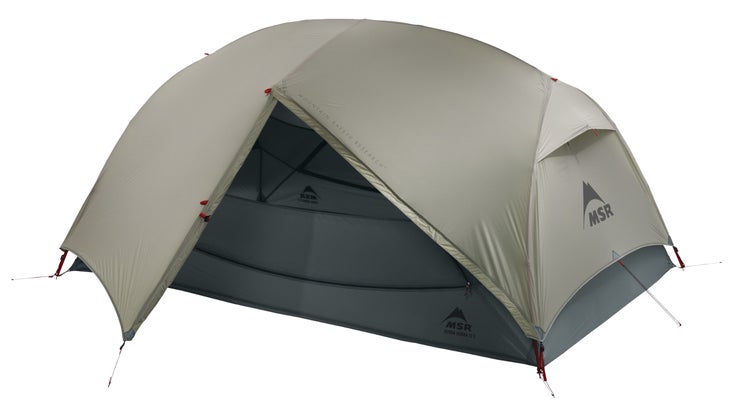
Best Organization
MSR Hubba Hubba LT 2
$550 at REI $550 at Backcountry
Weight: 3.4 lbs
Peak Height: 40”
Interior Space: 32 sq ft
Vestibule Space: 16 sq ft
Pros and Cons
⊕ Breathable
⊕ Very weatherproof
⊕ Great organization
⊗ Lower peak height
Our testers have long loved the Hubba Hubba for adventures at or above treeline, touting its combination of portability and weather protection. But it always felt like a high-elevation specialty tent: The amount of weather protection impeded ventilation, making it uncomfortable at lower elevations or in higher temps, and its livability was always sub-par.
A 2025 update addressed those concerns directly without sacrificing its benefits: The double-walled Hubba Hubba LT 2 has an additional three square feet of floor space and another square foot of vestibule space. MSR scaled back the fabric on the tent body in favor of an all-mesh tent top—increasing both ventilation and livability—while also improving the waterproof coating on the floor material (1200 to 1800 millimeters), and switching from carbon fiber to aluminum poles for durability.
“This version of the Hubba Hubba does a lot better in hot climates,” one tester reported after a backpack in Hawaii Volcanoes National Park. “More mesh and less fabric on the body means better airflow and a wider berth for stargazing compared to the original model.” The changes also greatly reduced condensation on cold mountain nights in Colorado and in wet-and-humid climates like Asheville, N.C. Despite all these updates, the packed weight increased by just two ounces.
The fly, tent body, and floor are all 20-denier nylon, with one-handed, smooth-running zippers. The side-loading stuff sack is a major plus for campers, as is packability at about the size of one and a half paper towel rolls. The interior organization is outstanding. “There are large pockets everywhere,” a tester said after a trek on the Art Loeb Trail. “Between the gear loft overhead and the long pockets at the head and on the side walls, there’s absolutely no need to keep any items on the floor.”
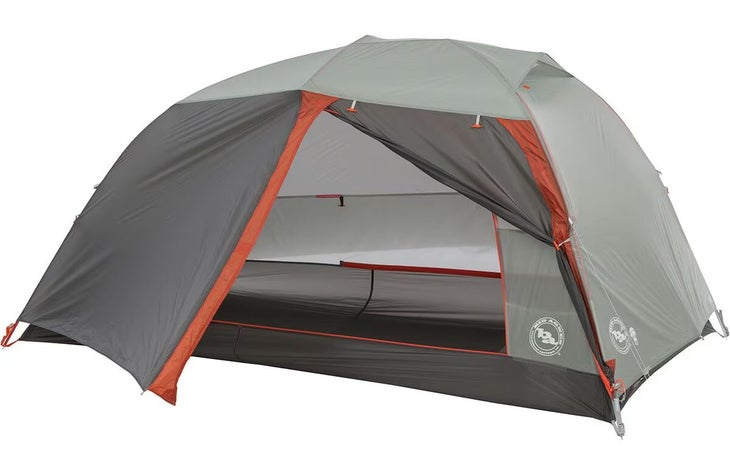
Paid Advertisement by Backcountry.com
Big Agnes Copper Spur HV UL2 MtnGLO Tent: 2-Person 3-Season
The Copper Spur HV UL2 MtnGLO Tent from Big Agnes combines a backpacking-worthy weight with an innovative LED light system. Rig gear, play games, check maps, or get that perfect tent glow shot with MtnGlo technology, a battery-powered LED lighting system sewn into the upper seams of the tent. Plus, enjoy an ultralight and breathable all-mesh body, the light and sturdy DAC Featherlite NFL pole system, and a seam-taped fly and floor to protect against rain and damp ground.
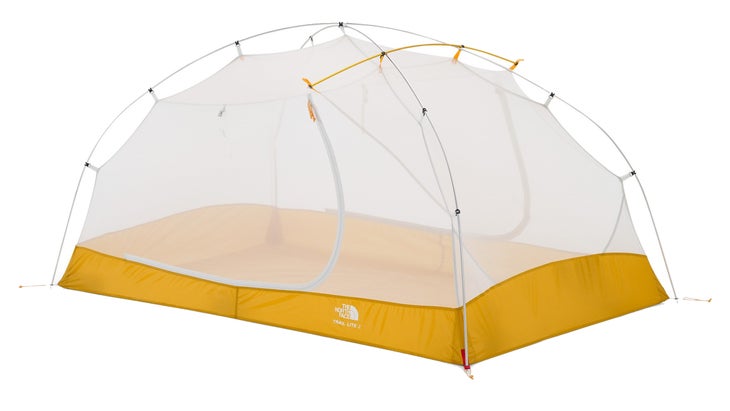
Best Budget Tent
The North Face Trail Lite 2
$325 at REI $325 at Backcountry
Weight: 5.1 lbs
Peak Height: 41″
Interior Space: 30 sq ft
Vestibule Space: 16 sq ft
Pros and Cons
⊕ Affordable
⊕ Easy setup
⊕ Solid weather protection
⊗ Heavy
Finding a budget tent is easy. Finding a budget tent where you can sleep soundly through shoulder season storms? Not so much. The $325 double-walled North Face Trail Lite 2 is the exception thanks to 9.5-millimeter aluminum poles, a 20-denier nylon ripstop fly with a 1,200-millimeter water-repellent coating, and a burly, 75-denier polyester bathtub floor. The latter adds weight but allows the tent to withstand abuse on rough terrain and keep dirt and water at bay.
“This is a three-season tent that I would feel comfortable pushing into the early winter,” said one tester from Baxter State Park in Maine. “It would perform fine in a light snow event because of its thick poles.”
Testers reported the Trail Lite 2 stood firm in sustained winds and deflected gusts up to 45 miles per hour, with four pre-attached guy lines that make hunkering down a breeze. The lack of a fly vent emphasizes the focus on weather protection, though an all-mesh body allows for adequate ventilation (and stargazing on clear summer nights), and our testers found no issues with condensation.
Inside, the peak height of 41 inches is maximized by pre-bent poles. “I was able to sit up straight in all four corners of the tent without touching the tent body or ceiling,” said a six-foot-tall tester after two nights in Big Cypress National Preserve. Overhead and side pockets make it easy to stay organized and enhance the 31-square-foot floorplan. Two eight-square-foot vestibules sit outside the oversized doors, big enough for large packs or foul-weather cooking.
Count the North Face Trail Lite 2 as the best budget option for weekend warrior backpackers. True, it weighs more than five pounds, which is a heavy load in today’s market. However, the tent’s price, livability, ease of setup, and weather protection make it a no-brainer for those who want a nearly all-season tent for half the price of the competition.
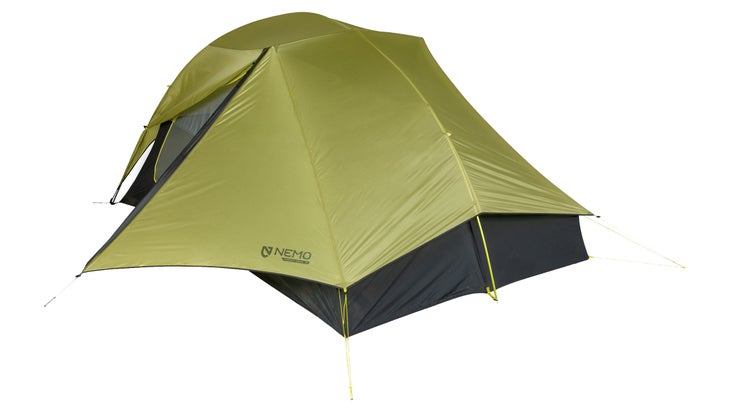
Best Space-to-Weight Ratio
NEMO Hornet OSMO 3
$530 at REI $550 at Backcountry
Weight: 3.3 lbs
Peak Height: 44”
Interior Space: 40 sq ft
Vestibule Space: 17 sq ft
Pros and Cons
⊕ Lightweight
⊕ Sustainable materials
⊕ Liveable
⊕ Packable
⊗ Tight storage
NEMO’s double-walled Hornet is a great tent in its two-person configuration. The three-person version? Next level. That’s thanks to its elite space-to-weight ratio, which adds 12 square feet at a cost of just 13 additional ounces, giving us a strong incentive to upgrade, even for two-person missions.
At just over three pounds, the Hornet is light enough to carry over long miles while providing adequate space for three tall backpackers: a generous peak height of 44 inches, 40 square feet of interior space, and an 88-inch length. Two 8.6-square-foot vestibules are decently sized (each vestibule will easily swallow a big pack and boots), although storage space is tight for three big packs. The tent body compresses down to the size of a Nalgene, and with only one hubbed pole, packability is exceptional.
“My 6’4″ partner could lay down without hitting his head or feet on the ends of the tent,” said a Durango, Colorado-based tester and Wilderness Medical Instructor. “It was the roomiest, most comfortable backpacking tent he’s experienced.”
The two-door tent is made of NEMO’s 100-percent recycled OSMO fabric, a proprietary combination of nylon and polyester that stood strong in inclement weather. “It’s a three-season tent, but it still handled a surprise snowstorm with gusty winds around 25 miles per hour,” reported another tester from Mt. Taylor’s 11,400-foot peak in New Mexico. “I stayed dry and comfortable inside.” And even with a trio jammed inside, condensation was a non-issue thanks to a three-quarter mesh body and pop-out vents.
Other Products We Tested
Hilleberg Anaris ($695): Testers liked the durability and weather protection of the Anaris, but it comes at a premium price point and was beaten out by less expensive options.
NEMO OSMO Dagger 2 ($500): An extremely liveable tent (30 square-foot interior, 24 square feet of vestibule space) with a high price that held it back.
Mountain Hardwear Meridian 2 ($360): Testers liked the price, spacious interior, and durability, but it was edged out by the Half Dome SL 2+ on overall livability.
Marmot Limelight 3 ($359): The Limelight stands out for its “side wing” interior vestibule, which some testers loved and others didn’t.
Alps Helix 2 ($250): The Helix 2 is roomier than average for tents in its class (31.5 square feet) and has excellent packability (the size of a two-liter soda bottle). Other budget tents edged it out in features, livability, and durability.
Kelty Far Out 2 ($200): An extremely appealing price and above-average durability (68-denier polyester construction) come with concessions on weight and livability that nagged our testers.
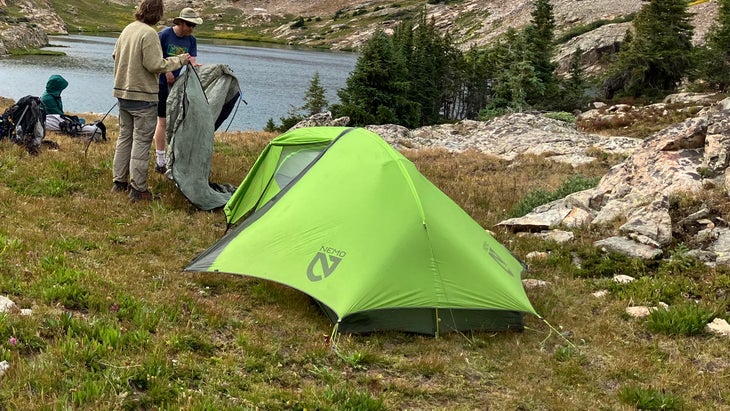
How to Choose a Three-Season Tent
Capacity, Size, and Vestibules
The first thing to consider when buying a tent is its size. You’ll want to know the number of people it’s designed to hold but also look closely at the square footage to ensure it will work for your specific needs. Check the length of the tent if you are more than six feet tall—a couple of extra inches of head and leg room are critical for a good night’s sleep, and not all tents are created equal. Pay attention to the amount of vestibule space a tent offers, especially if you plan to backpack in colder, more gear-heavy months.
Weight vs. Durability and Weatherproofing
While the best tents offer a lightweight balance of livability, weather protection, and durability evenly, those qualities often come at a weight penalty. Consider how far you’ll be hiking and how much weight you can comfortably carry over that distance. Some folks are happy to carry a five-pound tent that has a large floorplan and ample headroom, while others will prefer to minimize weight at the cost of comfort.
Once you get a sense of your maximum weight, think about the weatherproofing you’ll need in the environments you plan to visit. Campers in Florida have different needs than campers in Colorado. An all-mesh tent body will improve ventilation in hot climates but let wind, rain, and sand through in other climates. If heavy rain or bad weather is the norm for you, invest in heavier, more waterproof tent fabric and thicker, stronger poles. Burlier floor materials also add weight to the tent but offer more durability on abrasive ground.
Freestanding vs. Semi- vs. Non Freestanding
Another thing to consider is the type of pitch a tent uses. Freestanding tents are supported by a set of structural poles and can be pitched anywhere without the use of guy lines or added tension. They are the easiest to pitch but offer minimal customization in foul weather. Semi- and non-freestanding tents all use poles of some sort (structural aluminum poles or trekking poles), but need to be staked out using guy lines. This requires more patience and know-how when pitching, however it also allows the tent to be pitched in a variety of ways, making it easier to fit into tight spaces. Non-freestanding and semi-freestanding tents also typically weigh less than freestanding tents because they don’t come with as many—or any—poles.
Finally, a Pro Tip
Know the return policies. The only way to truly know a tent is to spend a couple of nights in it. Some stores and brands allow you to return used products without a penalty.
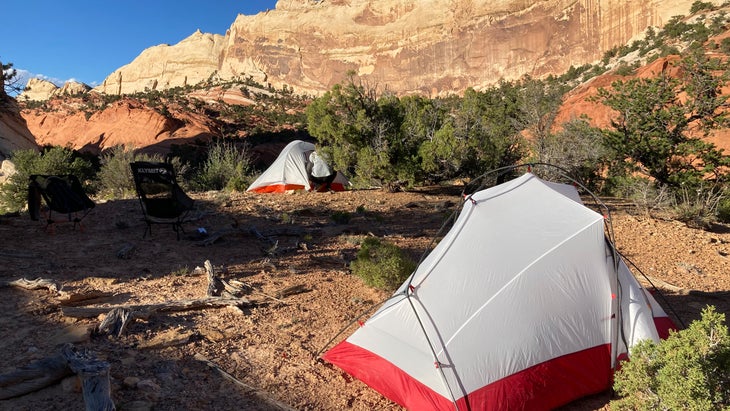
How We Tested
- Number of Testers: 9
- Coldest Temperature: 35 degrees (Alaska)
- Hottest Temperature: 101 degrees (Utah)
- Longest Stretch Stuck in a Tent: 11 hours
- Number of Nights Spent Outside: 75+
Our testing group spanned the country, in wilderness areas from Maine to California, in various temperatures and terrains, from near-freezing mountain peaks to triple-digit deserts. Testers come from a variety of backgrounds, genders, and professions, from public school teachers to park rangers. Over the course of the spring, summer, and fall months, these testers evaluated tents on a multitude of criteria, including livability, ventilation, design, weather protection, setup, and price, among other intangibles.
Meet Our Testers
Will McGough has been writing about the outdoors and testing tents for Backpacker and Outside since 2015. Specs aside, he believes the most important thing about a tent is how it makes you feel—a good tent should make you feel at home, regardless of climate and conditions.
Dorn Van Dommelen has hiked and skied in Alaska’s backcountry for 30 years and backpacked since he was a kid in Central Pennsylvania. Wherever he goes—multi-day-day backpacking trips in Denali NP, the Talkeetna Mountains, or near home in the Chugach State Park—he hauls a bunch of maps and a dog-eared copy of Nietzsche’s Zarathustra.
Mark Post is a Police Officer for the Town of Palisade in Western Colorado. He enjoys exploring the different regions of the Rocky Mountains, including the high country, where he tracks elk, bears, and deer.
